by Marcela M. | Jul 4, 2012 | Blog, Europe, Main courses, Recipe Box, Recipes, Salads and dips, Savories, Travel, Uncategorized
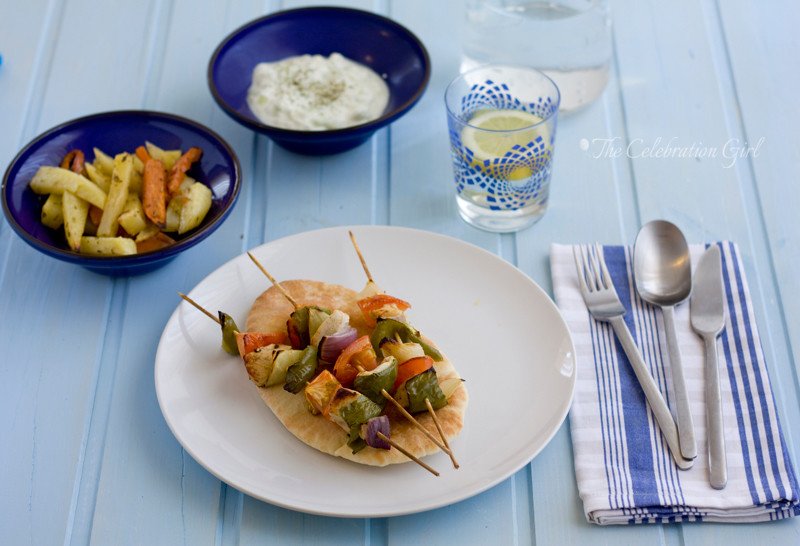
Good afternoon dear friends!
I hope you are having a lovely week! I hadn’t planned to take time off blogging but life took over my plans, and I had to attend to more urgent matters, which is why these recipes are being published late.I had originally planned to bring them to you on Monday the 18th of June (which was the official publication day for savory recipes at Circulo Whole Kitchen) but, as mentioned above, it was not possible. I didn’t want to miss the opportunity of publishing them, however because June’s proposal is very special to me, and because all flavours are summery and ideal for barbecues and outdoor entertaining.
During the month of June, Circulo Whole Kitchen’s savory proposal included three recipes which constitute a traditional Greek meal…and since I live in Greek Cyprus, they are a big part of my life and of my memories of this place . I have already shared one of these recipes with you, that of Tzaziki salad, and for the rest of the menu (which even included freshly baked pitta bread!), I used flavour combinations and marinades that I learnt here. It is my way of bringing you a part of my newly adopted culture, and my children’s first one.
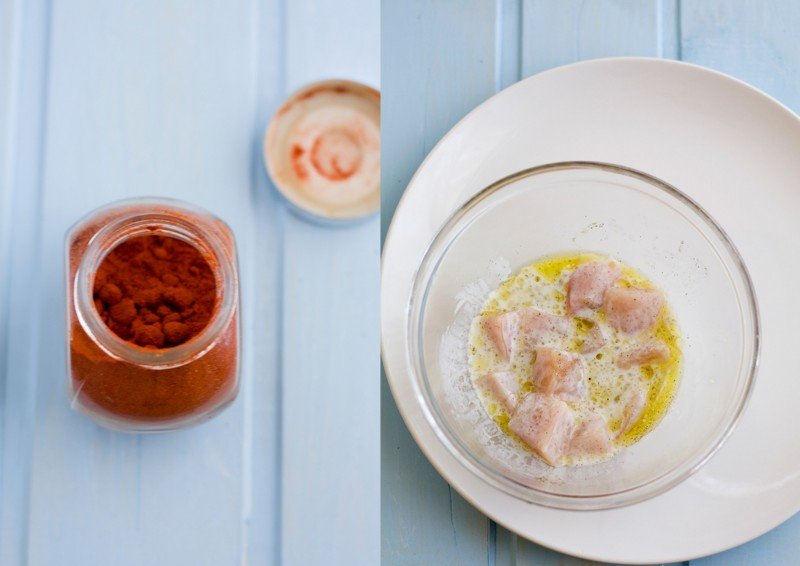
The first time I came to Cyprus was in August 2007, to visit my husband. At the time, I was still working in Ivory Coast (where we had met), and he had arrived to Nicosia a month before. I was meant to join him by the end of the year but we didn’t want to spend 6 months apart, so I took 10 days of vacations and came to see him during the summer. During weekdays, when he was at work, I would stroll the empty streets (Nicosia is a ghost city in August) and, on weekends, we would travel around the island, to get to know our new home. We visited Paphos, Limassol, Larnaca, Aphrodite’s birth place, Kakopetria and other places in between and we were captivated by the calm, quiet, leisure-like mood of the island.
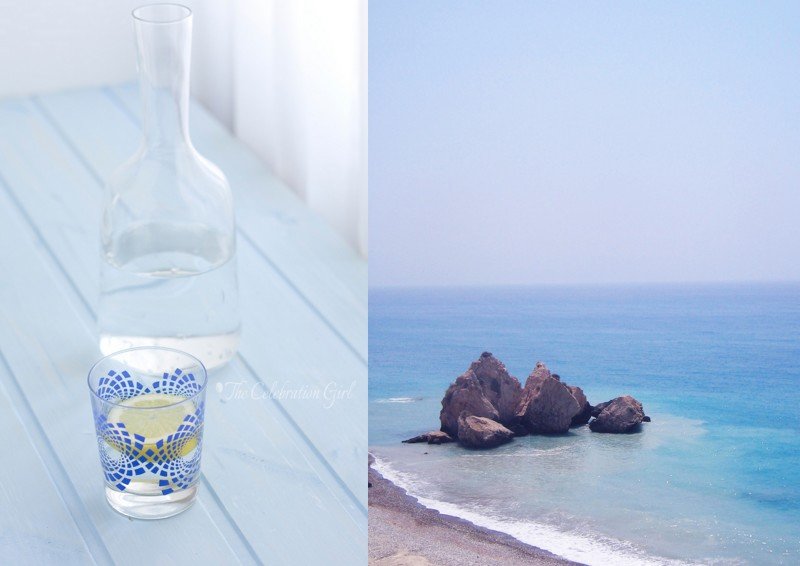
An important part of exploring a new place is, of course, tasting its food, and some of the foods we tasted were the ones that are the object of this post. Now, I had tasted souvlaki before, of course. We call them brochettes in Argentina, using the french word, and I had also had them as kebabs in Ivory Coast (called after their arabic denomination, which means “roast meat”) but the difference lied in the sauces used for marinating them. Until then, I was used to simply brushing meat and vegetables in olive oil and adding rosemary or thyme, or just lemon, and here were marinades that involved wine, cinnamon, yogurt, and french fries served with oregano. I was fascinated and remember scribbling the ingredients mentioned in the menu in paper napkins to try to emulate the recipes at home.
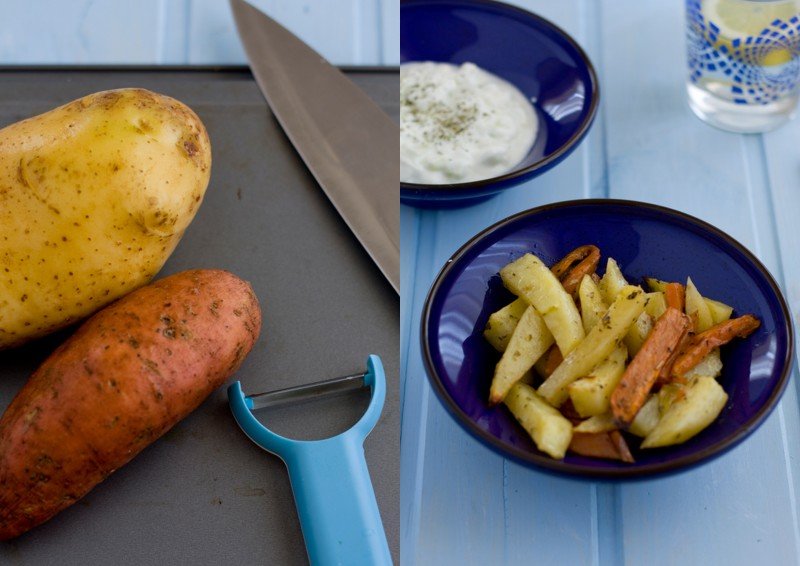
It is through experimenting with the recipes and comments generously provided to me by the people that came into my life since I arrived to Cyprus that I ended up with the chicken marinade for this souvlaki. I accompanied them with traditional tzatziki (using the recipe that my sister in law shared with me many years ago), and with oven- roast mixed potatoes, brushed in olive oil and sprinkled with oregano. For the pitta bread, I used the recipe provided by Circulo Whole Kitchen.
Here are the recipes:
Souvlaki:
Ingredients (for 8 sticks): 3 tablespoons greek yogurt, 3 tablespoons olive oil, 1 clove of garlic, crushed, 2 teaspoons paprika, salt and pepper to taste, 1 big chicken breast, 1/2 green pepper, 1 tomato, 1/2 red onion, 1/2 white onion, .
Preparation:
1) Mix yogurt, olive oil, garlic, paprika, salt and pepper in a bowl. Dice the chicken breast and add the pieces to the yogurt marinade. Cover with cling film and leave in the refrigerator a minimum of 5 hours (preferably overnight).
2) Dice the vegetables and set aside. Remove the marinating chicken from the refrigerator and start assembling the souvlaki, mixing meat and vegetables. Place them side by side on a baking dish brushed with olive oil and pour any remaining marinade over them.
3) Grill or cook in the oven until ready.
Pitta bread:
Ingredients: 500 grs all purpose flour, 2 teaspoons salt, 2 tablespoons olive oil, 240 ml warm milk, 240 ml warm water, 25 grs fresh yeast.
Preparation:
1) Mix flour and salt. Set aside.
2) Mix milk and water and pour over the yeast, mixing until dissolved
3) Add the the liquid mix to the flour and incorporate. Work the dough thoroughly, until really smooth and soft (this is important! do not skip this step!)
4) Form a ball of dough, place in bowl, cover with cling film and let it rest until it doubles its volume.
5) Flour the counter, put the dough on it, and pat it against the counter a couple of times, in order to remove air.
6) Cut the dough in small portions, cover with a kitchen towel and let them rest for about 15 minutes, in a warm place.
7) Once the small portions of dough have risen, roll them to give them a circular shape, until they are 1/2 cm thick. Place them in baking sheets, cover them and let them rise again.
8) Once risen, cook in a hot oven (220C) for about 6-10 minutes. They should not brown, only be crispy on the outside. Store them one on top of the other, covered with a kitchen towel for maximum freshness.
Oven-roast mixed potatoes:
Ingredients: 1 big potato and 1 big sweet potato, olive oil, oregano
Preparation:
1) Peel and cut the potatoes alongside (as if you were making French fries)
2) Place them on a roasting pan, and brush them with olive oil.
3) Mix salt with one tablespoon of oregano and sprinkle over the potatoes. Cook in the oven until just tender.
Tzaziki (originally published in this post)
Ingredients: 1 cucumber, 1 clove of garlic, greek yogurt and a little bit of parsley for garnishing.
Preparation:
1)Cut the cucumber into thin slices, and then chop them finely. Place them in a bowl.
2)Chop a clove of garlic (or half, if you are not a very garlicky person) and add it to the cucumber.
3) Add greek yogurt (500 ml) and mix well.
4) Chop a few parsley leaves to garnish.
Con sabor latino...
Buenas tardes queridos amigos!
Espero que esten pasando una hermosa semana! No había planeado tomarme vacaciones del blog y tardar tanto en publicar pero la vida se interpuso en mis planes y tuve que ocuparme de asuntos más urgentes, motivo por el cual estas recetas se publican recien hoy. Mi idea original era publicar este post el 18 de junio (ups!), que era el día oficial de publicación de las recetas del Circulo Whole Kitchen, pero, como mencioné anteriormente, lamentablemente ésto no fue posible. Elijo publicarlas, sin embargo, aún cuando haya pasado tanto tiempo, porque la propuesta del Circulo Whole Kitchen para el mes de junio tiene una importancia especial para mí, y porque todos los sabores incluidos son muy veraniegos, ideales para asados y reuniones al aire libre.
En el mes de junio,el Circulo Whole Kitchen nos invitó a preparar tres recetas tradicionales griegas…y como yo vivo en la parte griega de Chipre, estas recetas forman parte de mi vida diaria, y estos sabores forman parte de los recuerdos de esta tierra adoptiva que llevaré conmigo a donde vaya. Una de estas recetas (la de tzaziki), ya la compartí con ustedes en ESTE POST, pero la repito aquí para que no tengan que andar buscando en los archivos (aunque buscar en fácil ahora, no? 😉 Para el resto del menú, utilicé combinaciones de sabores y marinadas que aprendí aquí. Esta es mi forma de acercarles una partecita de mi cultura de adopción- y la primera de mis hijos.
La primera vez que vine a Chipre fue en agosto de 2007, para visitar a mi marido. En ese tiempo yo aún estaba trabajando en Costa de Marfil (donde nos habíamos conocido) y él había llegado a Nicosia un mes antes. Ya habíamos decidido que yo me le uniría aquí definitivamente a fines de ese año, pero 6 meses nos parecía demasiado tiempo para estar separados, así que yo vine a visitarlo durante 10 días en el verano para acortar el tiempo a la distancia. En esas vacaciones comenzamos a conocer la isla. Los días de semana, mientras él trabajaba, yo paseaba por las calles desoladas de Nicosia (que es una ciudad fantasma en agosto!) y, los fines de semana, explorábamos el que sería nuestro nuevo hogar. Así visitamos Pafos, Larnaca, Limassol, la roca donde nació Afrodita, Kakopetria y otros lugarcitos, y quedamos cautivados por el animo veraniego, calmado, tranquilo de la isla.
Una parte importante de explorar un lugar desconocido es, claro está, probar sabores nuevos, y algunos de esos sabores nuevos para mí son los que incluyo en este post. No, no es que haya probado souvlakis por primera vez en este viaje, de hecho en Argentina los llamamos brochettes (usando la palabra francesa) y tambien los había comido en Costa de Marfil (donde los llaman kebabs, usando la palabra árabe, que significa “carne asada”), pero la diferencia estaba en los condimentos utilizados y en la forma de emplearlos. Antes de venir a Chipre, cuando yo hacía brochettes no marinaba la carne, sólo la pincelaba en aceite de oliva y espolvoreaba romero o tomillo o, simplemente, limón…y de pronto aquí me encontraba con marinadas que utilizaban vino, canela, yogurt, paprika y las papas fritas se servian espolvoradas con oregano. Estaba fascinada con los nuevos descubrimientos culinarios, y anotaba los ingredientes que leía en los menus en servilletas de papel para hacer pruebas en casa, e intentar emular las recetas.
La marinada que usé en estos souvlaki de pollo fue producto, justamente, de esos experimentos nacidos de los comentarios generosos y de las recetas que me brindaron personas que aquí conocí. Los serví sobre pan de pitta casero y los acompañé con la tradicional tzaziki (hecha con la receta de mi cuñada) y con papas y batatas rostizadas al horno, pinceladas en aceite de oliva y espolvoreadas con sal oreganada. Espero que les gusten!
Aqui estan las recetas:
Souvlaki:
Ingredientes (para 8 palitos) : 3 cucharadas de yogurt griego, 3 cucharadas de aceite de oliva, 2 diente de ajo machucado, 2 cucharadas de te de paprika, sal y pimienta a gusto, 1 pechuga de pollo grande, 1/2 pimiento morrón verde, 1 tomate, 1/2 cebolla colorada, 1/2 cebolla blanca
Preparacion:
1) Mezclar en un bowl yogurt, aceite, ajo y paprika. Cortar el pollo en cubos y agregar a la marinada de yogurt. Cubrir con papel film y dejar reposar en la heladera un mínimo de 5 horas (preferentemente toda la noche)
2) Una vez transcurrido el tiempo indicado, cortar los vegetales en cubos y retirar el pollo de la heladera. Armar los souvlaki cuidando de intercalar distintas verduras con la carne. Una vez armados, colocarlos en una placa para horno pincelada con aceite de oliva y verter encima todo restante de marinada.Llevar a horno mpderado a fuerte hasta que estén cocidos.
Pan de pitta (receta de Circulo Whole Kitchen)
Ingredientes: 500 gr de harina, 2 cucharaditas de sal, 2 cucharadas de aceite de oliva, 240 ml. de leche tibia, 240 ml. taza de agua tibia, 25 gramos de levadura fresca
Preparación:
1) Poner en un bol la harina junto con la sal.
2) Mezclar la leche con el agua e incorporarla a la levadura mezclando hasta disolverla. Agregar esta mezcla a la harina, poco a poco, junto con el aceite de oliva e ir mezclando hasta que esté todo el líquido incorporado.
3) Formar una masa y comenzar a trabajarla en forma continua hasta que esté bien lisa y suave. Es importante que la masa esté bien amasada.
4) Colocarla en un recipiente y cubrirla con un plástico y dejarla levar hasta que doble su volumen.Una vez levada la masa se vuelca sobre una mesa enharinada.
5) Desgasificar la masa y cortar en porciones que se dejan descansar sobre una superficie enharinada y cubiertos con un paño. Preferentemente en un lugar cálido. Esto hará que nuestro pan leve en aproximadamente 10 a 15 minutos.
6) Se toma cada porción y se estira de medio centímetro de espesor en forma circular o alargada. Se van depositando en placas limpias, se cubren con un paño y se dejan levar nuevamente.
7) El secreto de estos panes es cocinarlos en un horno a una temperatura alta , unos 220º, para que se inflen y formen corteza pero sin color, deben quedar blancos. Los dejamos hornear durante unos 6 a 10 minutos.
8) Para conservarlos blandos se apilan unos sobre otros en caliente y se cubren con un paño, o plástico.
Mix de papas y batatas oreganadas al horno:
Ingredientes: 1 papa grande común, 1 batata, aceite de oliva para pincelar, oregano para espolvorear
Preparacion:
1) Cortar las papas en bastones, como si fueran papas fritas.
2) Colocar las papas en una fuente de horno y pincelar con aceite de oliva.
3) Mezclar la sal con una cucharada de oregano y espolvorear sobre las papas. Cocinar en horno moderado hasta que esten tiernas.
Tzaziki:
Ingredientes: 1 pepino, 1 diente de ajo (o medio, si no quieren espantar vampiros ;), yogurt griego (o yogurt natural, si no encuentran), perejil para espolvorear arriba antes de servir
Preparación:
1) Cortar en pepino en rodaja bien finitas, y luego picarlo hasta que quede chiquito.
2) Picar el diente de ajo muy finito.
3) Agregar el yogurt y mezclar bien.
4) Antes de servir, picar unas cuantas hojas de perejil y espolvorearlas encima.
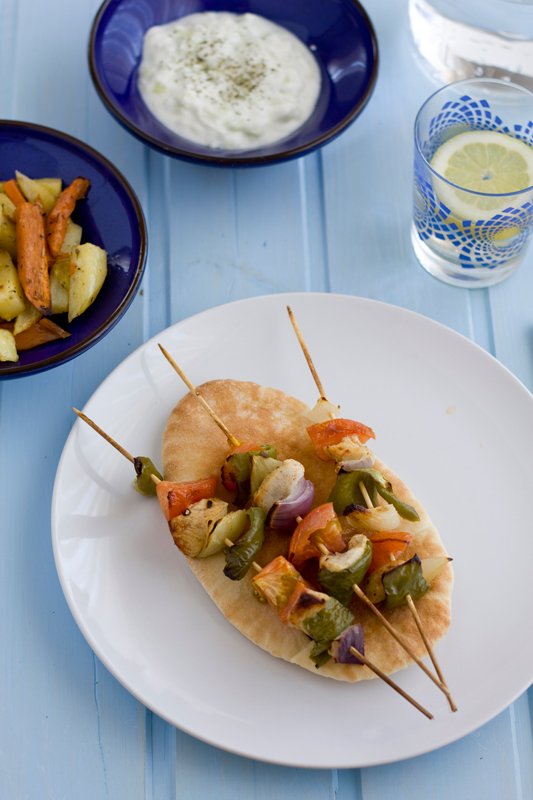
I hope you like these recipes!
What is the dish that spells summer to you?
PS: Happy 4th of July to all my American followers! May you be enjoying a wonderful day with family and friends!
by Marcela M. | Jun 25, 2012 | Blog, Cakes, Mousses and ice cream, Recipe Box, Recipes, Sweets, Uncategorized

Good morning dear friends! I hope you had a lovely weekend.
Summer arrived in Nicosia all of a sudden and, in a way took me by surprise. We had had a relatively mild Spring until a couple of weeks ago and, as the end of June started to approach, temperatures began to rise and rise and we are now averaging 35 C every day, with peaks of 41C. These are the usual Summer temperatures around here, so we have developed a few strategies for coping with the heat. These involve light clothing, frequent showers, lots of lemonade and -you guessed it- avoiding to turn the oven on as much as possible.
This is why, when Circulo Whole Kitchen proposed to its members to prepare a charlotte for the June challenge, I was thrilled: here was a dessert I had never attempted to make, relatively easy, and that required no baking! Perfect!
Charlotte is a very simple dessert, which knows different variations: the cake mold lining can be made with ladyfingers, swiss roll or sponge cake, and the fillings may include fruit purée, mousses or custard. The recipe I chose to prepare in this occasion (inspired by this one) uses ladyfingers, and is filled with a combination of red fruits mousse ( made with fruit purée, whipped cream and gelatin) and white chocolate mousse (made with melted white chocolate, whipped cream and gelatin). Its preparation takes approximately 15 minutes and needs to be chilled for about 5 hours before serving.
Since this was my first time making it, my charlotte doesn’t look as perfect as I would have liked it to. This is because of two reasons: 1)I over-dipped the cookies in syrup, which made them too soft, and it was therefore difficult for them to keep their shape. 2) I lined the bottom before the sides, so the bottom of the side cookies was too wet and the cookies tended to open when removed from the mold. So now I know better! The next time I will barely dip the cookies and I will make sure that the sides are line first. I hope that with these tips your own charlottes will come out perfect!
Despite these setbacks, I am quite happy with these charlottes because they passed the taste test (which, I believe, is the most important one when it comes to food!). They are a simple, delicious dessert, that looks pretty and is ideal for summer entertaining.
Here is the recipe;
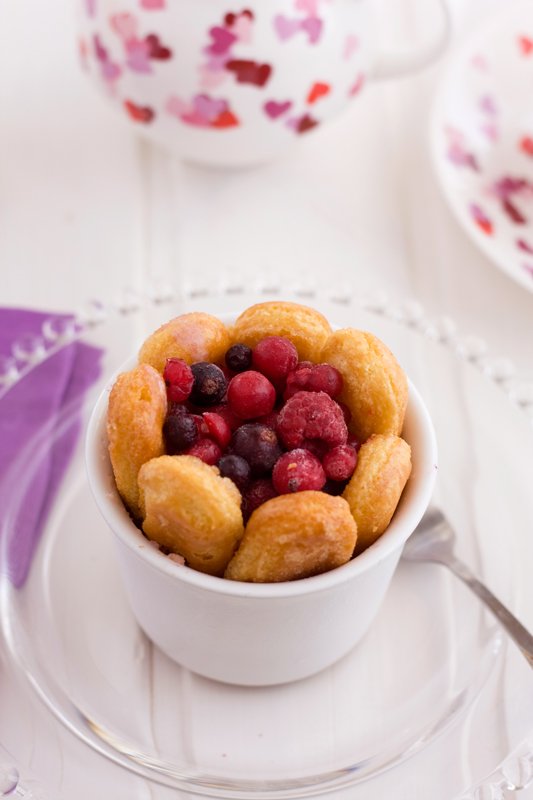
Red fruits and white chocolate charlotte
Ingredients:
– 1 pack of ladyfingers (or enough to completely cover sides and bottom of a 6 inch cake pan or 6 ramequins)
– sugar syrup, made with 100 grs of sugar, covered with water and put to boil for a few minutes. You may flavour the syrup with dessert wine, like oporto or marsala, or even with coffee or orange juice and zest (depending of the flavour of the charlotte itself).
– 150 grs white chocolate, melted and cooled to room temperature
-150 grs red fruits (I used a frozen berry mix, that I defrosted in the refrigerator)
– 1 envelope of unflavoured gelatin
– 100 ml of heavy cream
– 4 tablespoons of icing sugar
Preparation:
1) Prepare the sugar syrup. Slightly dip enough ladyfingers and line a mold of the desired size with them.
2) Dissolve the gelatin in half a cup of warm water. Add 1/4 cup of cold water to cool it down. Divide in half. Set aside.
3) Melt the white chocolate and let it cool.
4) Wash the red fruits (I used a mixture of cranberries, blueberries, raspberries and strawberries) and process them (you may use a blender for this purpose). Pass the resulting purée through a sieve and set aside the pieces that were too big.
5) Whip the heavy cream together with the icing sugar, until firm (“en chantilly”). Divide in two and set aside.
6) Mix the red fruits pulp with half the whipped cream, with circular movements. Add half the gelatin and mix it in, slowly. Set aside.
7) Mix the melted and cooled white chocolate with the remaining half whippedcream. Add the gelatin and mix it in, slowly. Set aside
8) At this point you will have two mousses, and you can do two things: 1) Fill the lined pan with the red fruits mousse, let it cool for a few minutes in the refrigerator, add a layer of ladyfingers and then add the white chocolate mousse, or 2) Fill the lined pan with the red fruits mousse and, then, add the white chocolate mousse in the middle and draw designs with a skewer to marble it.
9) Leave in the refrigerator for 4 to 5 hours, unmold and serve with red fruits on top ( don’t worry, it comes out of the pan easily!)

Con sabor latino
Buenos días queridos amigos! Espero que hayan pasado un hermoso fin de semana!
El verano llegó a Nicosia de repente y me tomó por sorpresa. Hasta ahora veníamos teniendo una primavera con temperaturas moderadas pero,a medida que junio comenzó a llegar a su fin, éstas comenzaron a ir en aumento y ahora estamos con un promedio de 35C diarios, con picos de 41C. Estas son temperaturas comunes durante el verano chipriota, asi que a estas alturas ya hemos desarrollado algunas estrategias para hacer frente a tremendo calor, que incluyen ropa liviana, ducharnos varias veces por día y-como se imaginarán- evitar a toda costa encender el horno.
Por este motivo, me alegré cuando ví que Circulo Whole Kitchen proponía como receta dulce para el mes de junio una charlotte, postre que nunca había preparado antes, relativamente sencillo y que no requería cocción! Perfecto!
La Charlotte es un postre sencillo, del cual existen muchas variantes, que van desde el tipo de galletas con el que se cubre el molde en el que se lo realiza (vainillas, pionono, o torta esponjosa), hasta el relleno (que puede consistir en puré de frutas, mousses diversas o crema. La receta que yo elegí en esta ocasión (inspirada en esta) utiliza vainillas y un relleno compuesto de dos mousses: una de frutos rojos (yo utilicé arandanos, frambuesas, grosellas y frutillas, procesados, y mezclados con crema chantilly y gelatina sin sabor) y otra de chocolate blanco (hecha a base de chocolate derretido, crema chantilly y gelatina sin sabor, para darle consistencia). La preparación lleva tan sólo 15 minutos, pero requiere reposo en la heladera/refrigerador por aproximadamente 5 horas.
Como ésta era mi primera vez haciendo este postre, mis charlottes no lucen todo lo perfectas que me hubiera gustado. Esto se debe a dos motivos: 1) Exageré al remojar las vainillas en almibar y quedaron demasiado blandas, lo que complicó que mantuvieran la forma y 2) Recubrí con vainillas el fondo del molde, antes que los lados, entonces las vainillas que se encontraban a los lados se humedecieron demasiado con las mousses en la parte de abajo y tendieron a abrirse al desmoldarlas. Lo bueno es que ya aprendí que para la próxima tengo que mojar apenas las galletas y poner primero las galletitas de los costados. Espero que estos datos les sirvan a ustedes para poder alcanzar la perfección de entrada!
Igualmente, a pesar de estos errores, estoy muy conforme con el resultado de este postre porque de gusto estaban riquísimas (y, en definitiva, eso es lo que importa cuando se trata de comida, verdad?) Ademas son sencillas, deliciosas y lucen bonitas y son ideales para eventos de verano.
Así que sin más, esta es la receta. Espero que les guste!10
Charlotte de chocolate blanco y frutos rojos
Ingredientes:
-1 paquete de vainillas (o las que sean suficientes para recubrir el o los moldes que vayan a usar. El relleno es suficiente para un molde de 15. 4 cms, o 6 ramequins)
– almibar, hecho con 100 grs de azucar, recubierta con agua y llevada a fuego por unos minutos (que no se pase, que no quieres hacer caramelo!)
– 150 grs de chocolate blanco derretido y enfriado (tiene que estar a temperatura ambiente)
– 150 grs de frutos rojos
– 1 sobre de gelatina sin sabor
– 100 cm3 de crema de leche
– 4 cucharadas de azucar impalpable
Preparación:
1) Prepare el almibar. Coloque el azucar en un jarro, recubra con agua y lleve a fuego por unos minutos, hasta que la mezcla espese ligeramente. Remoje las vainillas en el almibar y recubra con las mismas el molde a utilizar.
2) Derrita el chocolate a baño maría (o en el microondas, si tiene uno). Deje enfriar hasta que quede a temperatura ambiente.
3) Procese los frutos rojos en la procesadora o licuadora. Pase el puré por un tamiz hasta obtener la pulpa.
4) Bata la crema de leche a punto chantilly con el azucar impalplable. Divida en dos partes iguales y reserve.
5) Disuelva la gelatina sin sabor en media taza de agua caliente. Agregue 1/4 taza de agua fria para bajar la temperatura. Divida en dos y reserve.
6) Mezcle la pulpa de frutos rojos con la mitad de la crema chantilly y, una vez bien incorporado, agregue la mitad de la gelatina sin sabor. Reserve
7) Mezcle el chocolate blanco con la mitad de chantilly restante, e incorpore luego la gelatina sin sabor que había reservado.
8) Rellene el/los moldes con mousse de frutos rojos. A continuación, tiene dos opciones; 1) Colocar el molde en la heladera unos minutos (hasta que tome un poco de consistencia) y a continuacion, agregar una capa de vainillas y luego la mousse de chocolate blanco o 2) Una vez rellenado el molde con la mousse de frutos rojos, agregar la mousse de chocolate blanco inmediatamente en el centro y luego hacer dibujos con un palito de brochette, para marmolarla.
9) Coloque el/los moldes en la heladera/refrigerador por 4 a 5 horas. Desmolde y sirva con frutos rojos (no se preocupe, se desmolda super facilmente!)
I hope you’ll like it!
See you later this week!
by Marcela M. | Jun 4, 2012 | Blog, Cakes, Recipe Box, Recipes, Sweets

Good evening dear friends!
Today it was a holiday in Cyprus, Kataklismos, the flood festival, which is why I am posting this recipe late. My children were at home, so we took them to a nearby park early in the morning and then we stayed home, playing and just enjoying the day together. The weather is beginning to get hot and at 8:00 am the sun is already up in the sky, shinning strong, which is why we go to the park so early that we are generally the only ones there!
We are lucky to live very close to a very beautiful park, with a nice playground, a basketball court, and a beautiful lawn with palm trees, pine trees and tile trees, as well as a pond and a water fountain where birds and butterflies fly around, and stray cats look for someone to pet them for a while. Luka and Zoe love and look forward to our mornings there, playing ball, walking around, chasing birds and sitting by the pond, and we are happy to take them out of the apartment, to enjoy nature.
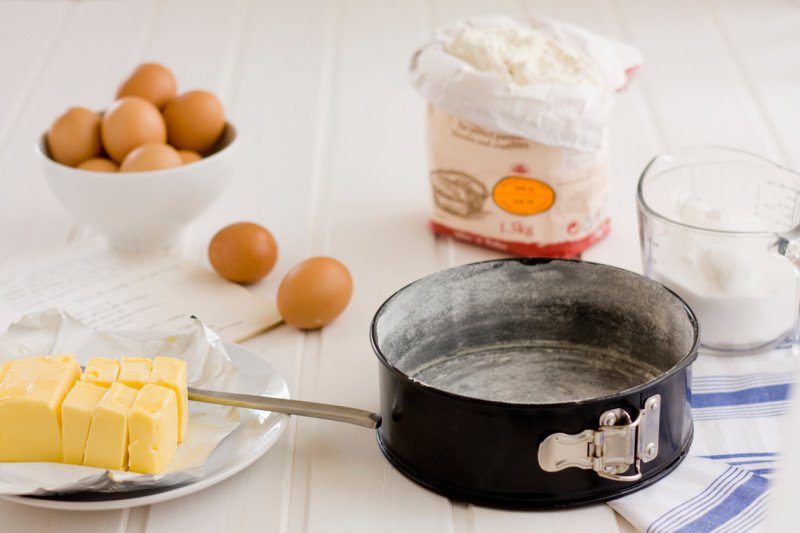
Now let’s get to the recipe you have been waiting for!
I have been doing this cheesecake for about 15 years and, every time, it is a huge success. I don’t remember exactly how I came up with it because I have it scribbled in my old recipe notebook, but I believe it was written on the foil cover of a pack of ricotta cheese from a famous Argentinian brand (Mendicrim). I do remember that I had been looking for a good cheesecake recipe for a while, and for some strange reason I tried this one first, instead of one the 101 that my mother had in a specific recipe book! I also remember that most recipes I had seen before called for a cookie-based crust, and that many specifically mentioned digestive cookies (which do not exist in Argentina), which had put me off trying them. I have tried many cheesecakes since then and I always go back to this one. It is, in my opinion, just perfect. I hope you will find it perfect too.
The beauty of this recipe is that it is very simple to make (no special appliances needed), and that you can find all ingredients in almost any country, in the Western world at least. It is a cooked cheesecake, with a barely sweet crust made from scratch, and a filling that is soft, not overly sweet and extremely delicious. I particularly like how the crust’s flavour doesn’t overpower the filling, which is the recipe’s true hero. I normally top it by brushing a little strawberry jam and decorate it with sliced strawberries, but this time I decided to change and use fruits of the forest instead. I had a pack of frozen fruits of the forest, which I slowly defrosted overnight in the refrigerator before adding them to the cake, right before serving. It was delicious.
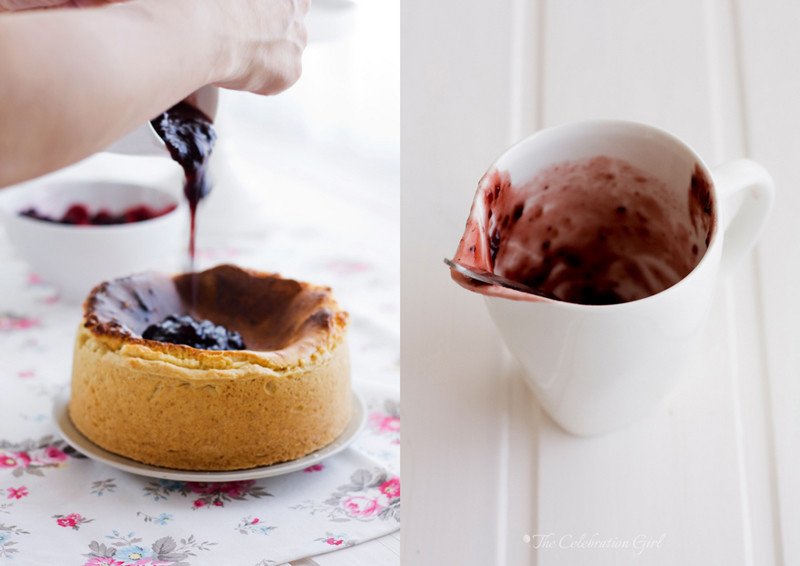
The quantities are enough for a 9 inch/20 cms cake pan, but you can also make individual mini cheesecakes, or a taller, narrower cake. Beware, though, that the cake does rise a little in the oven and if you fill the pan to the very top, the filling may overflow. So, whichever pan you choose, remember to leave some space between filling and top of the pan!
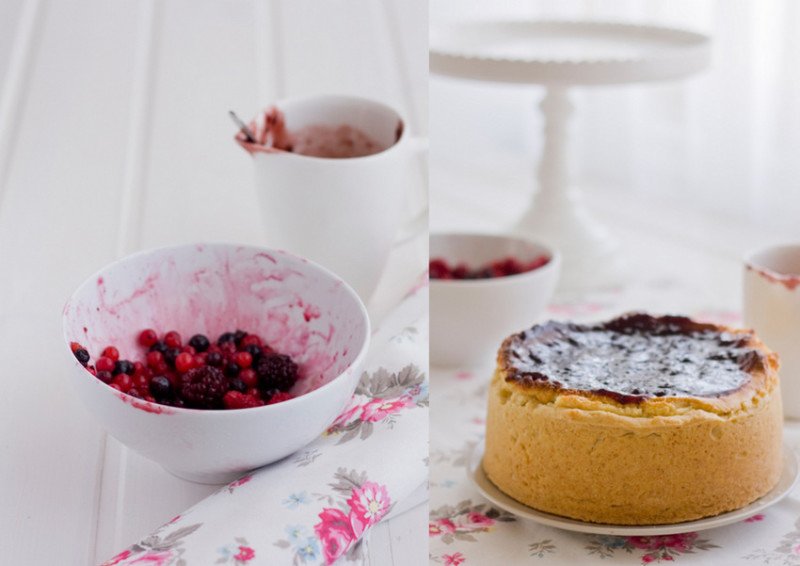
Now, without further ado, here is the recipe for my favourite cheesecake ever:
Ingredients:
For the crust: 200 grs of flour, 1 teaspoon baking powder, 2 tablespoons sugar, 75 grs soft butter or margarine, 100 cc milk. (Note: If the butter is too soft, you may need to reduce the quantity of milk or the dough will be too sticky)
For the filling: 250 grs cream cheese (I use philadelphia in Cyprus, and queso blanco in Argentina. The original recipe called for ricotta but I don’t like it that way), 2 egg yolks, 3 tablespoons cornstarch, 1 small can of sweetened condensed milk (397ml/14 oz), 2 teaspoons pure vanilla extract, 2 egg whites, beaten until stiff.
Preparation:
Prepare the crust: Put flour, baking powder and sugar in a bowl and mix with a whisk. Cut butter in small pieces and add to the flour mixture, mixing it in using your hands. Start adding milk slowly, until you can form a ball with the dough. Cover with foil and bring to the refrigerator for 15 minutes.
Prepare the filling: Put cream cheese, egg yolks and cornstarch in a bowl and mix well. Add sweetened condensed milk slowly and mix thoroughly, until no lumps are visible (using a hand or stand mixer can be handy if you have one, but it is in no way a requisite. It will just take a little bit longer to get rid of the lumps without it, that’s all). Add vanilla extract and mix in well. Add the beaten egg whites, and incorporate using a spatula, in circular motion.
Assemble the cheesecake: Pre- heat the oven at 175 C. Oil and flour a cake pan. Take the dough out of the refrigerator and roll it about 1/2 cm thick. Wrap the dough in the rolling pin and lift it to cover the pan, attaching it well to the sides (it has a tendency to fall over the filling if you don’t press it well). Pinch sides and bottom with a fork. Pour the filling inside the pan and pat it on the counter to make sure it is even. Cook for about 50 minutes, or until the filling stops feeling wobbly when slowly shaking the pan back and forth (in order to check for readyness, take the pan with both hands while still in the oven and move it back and forth. If the filling moves, it is not ready). Note: using cooking times as a guideline onky, because they vary greatly from oven to oven. The most accurate method for guaranteeing that the filling will be firm when you cut it is the simple one of giving it a little shake. Once the cake is ready, turn the oven off and let it rest inside for 15 minutes (or the filling will swamp, as it happened to me because I forgot!). After this time, remove from the oven and let cool.
Decorate: Once the cake is completely cool, brush it with jam and add the fruits of your choice on top right before serving. Note: As you can see in the pictures above, I added generous amounts of jam. I don’t normally do that, but I had forgotten to leave it in the oven after finishing the baking process and it swamped in the middle, so I covered the hole with jam and added extra fruits.

Con sabor latino:
¡Buenas noches queridos amigos!
Hoy fue feriado en Nicosia, Kataklismos o el Festival de la Inundación, motivo por el cual publico esta receta tan tarde. Mis hijos estuvieron en casa todo el día, y aprovechamos para llevarlos al parque cercano temprano por la mañana y, luego, nos quedamos en casa jugando y disfrutando del día juntos. El clima ya comienza a tornarse muy caluroso y a las 8:00 am ya el sol está alto en el cielo, brillando fuerte, motivo por el cual vamos al parque tan temprano que frecuentemente somos los únicos allí!
Afortunadamente, vivimos cerca de un parque hermoso, con un area de juegos, una cancha de basket, y una bellísima explanada con palmeras, pinos y tilos que dan sombra, y una fuente de agua alrededor de la cual vuelan pájaros y mariposas, y donde gatos callejeros buscan alguien que les haga un mimo. Luka y Zoe adoran ir y esperan con ansias nuestras mañanas allí, jugando a la pelota, caminando, persiguiendo pajaritos y sentandonos a la orilla de la fuente, y a nosotros nos hace felices sacarlos por un rato fuera del departamento, para que disfruten de la naturaleza.
Pero basta de prolegómanos, y pasemos directo a la receta que estaban esperando!
Esta es una receta que hago desde hace alrededor de 15 años y, cada vez, es un exito tremendo. No recuerdo exactamente de donde la saqué, pero creería que la encontré en la tapa de aluminio de un pote de ricotta Mendicrim. Recuerdo, sí, que para ese entonces ya hacía bastante que yo venía buscando una buena receta de cheesecake y, por alguna extraña razón, me decidí a probar esta primero, antes que las 101 que tenía mi mamá en un libro especialmente dedicado a este tipo de tortas. Recuerdo también que la mayor parte de las recetas que había encontrado hasta ese momento tenían una base de galletitas, y que muchas de ellas requerían un tipo específico que no se encuentra en Argentina (las galletitas digestivas), lo que me había hechado atrás para probarlas. He probado muchas cheesecakes desde entonces, y siempre he preferido la de esta receta. Es, en mi opinión, simplemente perfecta. Espero que a ustedes les parezca igual!
La belleza de esta receta es que es muy sencilla de hacer (no se requieren instrumentos especiales), y que pueden encontrarse los ingredientes en la mayor parte de los paises del mundo occidental, al menos. Es una cheesecake cocida, con una base casera levemente dulce, y un relleno suave, no demasiado dulce e increiblemente delicioso. Una de las cosas que más me gusta es que el sabor de la base no opaca el relleno, sino que lo deja brillar, ser el heroe de la receta. Generalmente la termino pincelándola con mermelada de frutilla y decorandola con frutillas fileteadas ubicadas en circulos concentricos, pero esta vez decidí utilizar frutos del bosque en lugar de mi decoración tradicional. Había comprado hace ya un tiempo una caja de frutas congeladas, que dejé en la heladera toda la noche, en un bowl, y agregué a la torta justo antes de servir. Quedó exquisita.
Las cantidades son suficientes para un molde de 9 pulgadas/20 cms de diametro, pero tambien pueden prepararlas en versión mini, o bien en un molde ligeramente más pequeño y alto, pero tengan cuidado en este caso porque si el relleno llega al borde, es muy posible que el mismo rebalse durante la cocción ya que la torta crece un poco en el horno. Cualquier sea el molde que elijan, entonces, cuiden de no llenarlo hasta el tope. Y les recomiendo, asimismo, que sea de aquellos que se retira el costado, porque será más facil de desmoldar.
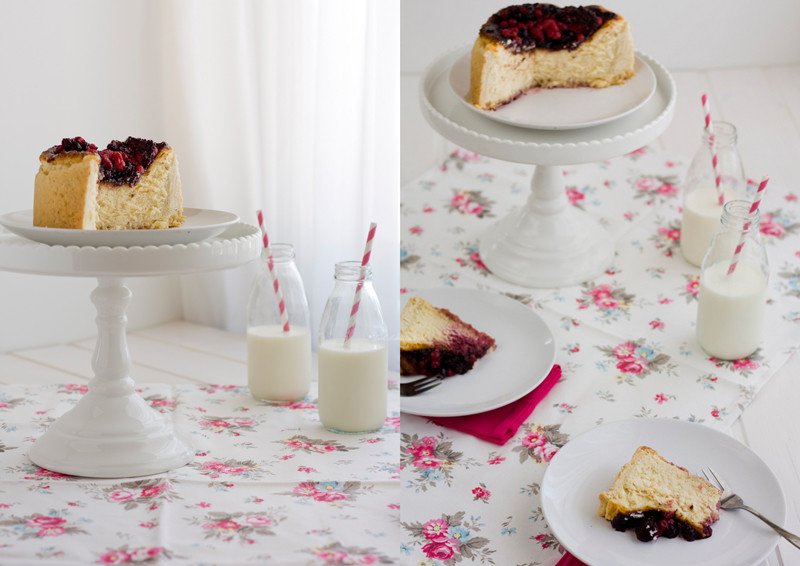
Ahora sí, sin más introducciones, he aquí la receta:
Ingredientes:
Para la masa: 200 grs de harina, 1 cucharada de té de polvo de hornear, 3 cucharadas soperas de azucar, 75 grs de manteca, 100 cc de leche. Nota: Si la manteca está demasiado blanda, será necesario agregar menor cantidad de leche or la masa estará demasiado pegajosa y no se podrá armar un bollo con ella.
Para el relleno: 250 grs de queso blanco o queso philadelphia (en Argentina usaba mendicrim o casancrem, pero usen el que más les guste!. La receta original pedía ricotta pero no la hago así porque no me gusta). 2 yemas, 2 cucharadas de fecula de maiz (maizena), 1 lata chica de leche condensada azucarada (397 grs), 2 cucharaditas de té de esencia de vainilla, 2 claras batidas a nieve.
Preparación:
Prepare la masa: Coloque harina, polvo de hornear y azucar en un bowl y mezcle todo con un batidor de alambre. Agregue la manteca cortada en trozos, desmenuzandola con los dedos e integrándola con los ingredientes secos. Agregue la leche de a poco, hasta que se pueda formar un bollo de masa. Cubra con papel film y lleve a la heladera por 15 minutos.
Prepare el relleno: Coloque yemas, fécula y queso crema en un bowl y mezcle hasta que esté todo bien incorporado. Agregue la leche condensada poco a poco, integrando bien y batiendo para que no queden grumos ( Si tiene batidor electrico, aproveche y usela porque será mas facil librarse de los grumos, pero sepa que si no cuenta con una, no hay problema). Agregue la vainilla e incorpore. Agregue las claras batidas a nieve al batido de queso, incorporandolas con movimientos envolventes.
Arme la cheesecake: Precaliente el horno a 175 grados. Retire la masa de la heladera, y estirela sobre la mesa o mesada hasta que tenga aproximadamente 1/2 cm. Envuelvala en el palote para levantarla y cubra el molde deseado, previamente enmantecado y enharinado. Presione la masa con los dedos para que se adhiera bien al molde y pinchela con un tenedor (para que no se levante mucho en el horno). Vierta el relleno sobre la masa, y empareje dando golpes contra la mesada. Lleve a horno durante aproximadamente 50 minutos, o hasta que el relleno deje de moverse al sacudir ligeramente el molde. Nota: Le aconsejo que se guíen ligeramente por los tiempos de cocción porque pueden variar mucho de un horno a otro, el mejor método para saber si está lista y si no se desarmará al cortar es, simplemente, tomar el molde con ambas manos cuando aún está en el horno, y moverlo apenas. Si la torta “se mueve”, no está lista. Una vez lista, apague el horno y deje la cheesecake dentro durante 15 minutos ( si no lo hacen y la retiran inmediatamente se hundirá como me ocurrió a mí por olvidadiza!0. Transcurrido este tiempo, retirela del horno y deje enfriar.
Decore: Una vez que la torta esté totalmente fría, pincele con mermelada y cubra con frutas de su preferencia justo antes de servir. Nota: Como pueden ver en las fotos anteriores, yo no pincelé sino que cubrí con cantidades generosas de mermelada. La razón es que mi cheesecake se habia hundido al medio, así que rellené el hueco con mermelada y frutas!
I hope you like this recipe! It is one of my favourites!
Have a wonderful week, and see you on Thursday!
by Marcela M. | May 25, 2012 | Blog, Cakes, Recipe Box, Recipes, Sweets, Uncategorized
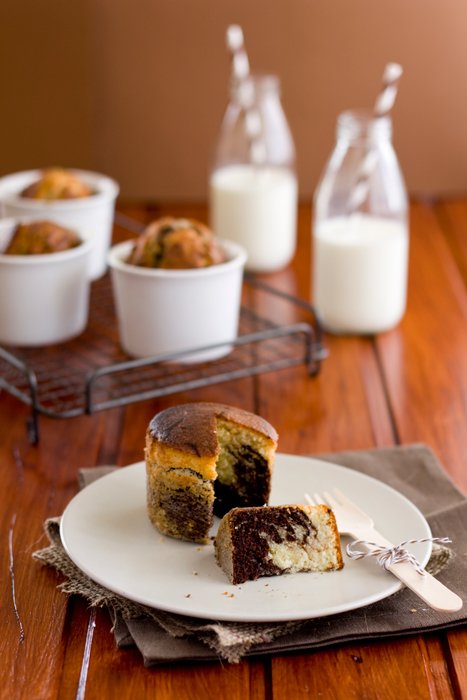
Good morning dear friends!
Today I bring you another recipe from Circulo Whole Kitchen. As I mentioned in my post from last week, this month I started participating in the culinary challenges proposed by Whole Kitchen Magazine, and their sweet suggestion for May 2012 was the ultra popular zebra cake.
The zebra cake is, basically, a vanilla and chocolate cake, marbled to resemble the stripes of a zebra. This is achieved by putting the batter in the pan one or two spoons at a time, alternating colours. When looked from the top, the cake looks like a succession of circles, but when cut in slices, the zebra stripes appear, making it an instant hit with children- and with adults!
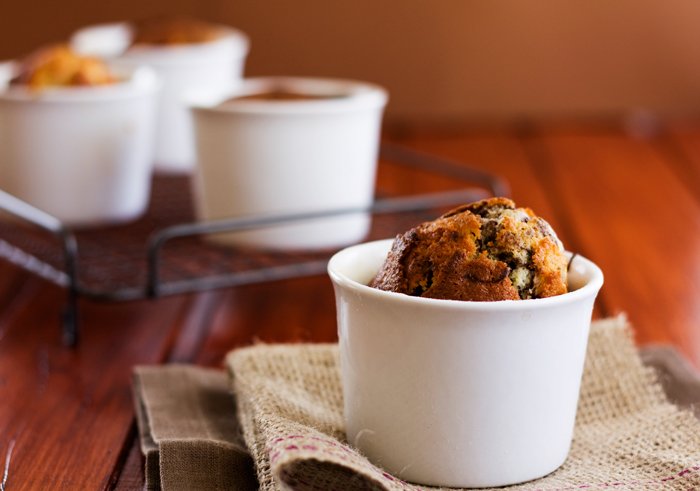
In this occasion, I used the recipe provided to us by Whole Kitchen and followed the directions exactly, because I am always happy to try ones, but know that since the effect is mainly visual, you can simply use your favourite vanilla cake recipe, divide the batter in two, add two tablespoons of cocoa (I prefer dark cocoa) to one half, and go ahead with the method for placing the batter in the pan, as you would with this one. And you could even use a boxed cake or change flavours and colours!
This recipe is a very nice one, though, and I encourage you to try it. It is a simple cake, with a spongy texture (because the eggs are beaten with the sugar until white, which makes them fluffy) and not overly sweet. It makes a nice everyday coffee cake, but if you are making it for a child’s party, you could also cover it in chocolate ganache, or cover the sides with peanuts (as Kim did here, for example, and then the zebra stripes could come out as a surprise! The cake’s pattern would be perfect for birthday themes such as Safari, Young Explorers, Animals, Madagascar (the movie) or Africa.
The only variation I introduced to the original one, was the size of the pan: instead of baking my zebra cake in a normal sized pan, i did it in small ramequins. I like to bake cakes in small containers so that I can freeze those that will not be eaten immediately without losing freshness. This batter is enough for a 9 inch pan, or for 6 ramequins (mine are from Ikea). I do have to point out, though, that the effect of the zebra stripes is less noticeable when baked in small pans, as you can see from my pictures. So, if you want the full wow effect of the zebra stripes, it is probably better to stick to the traditional size.
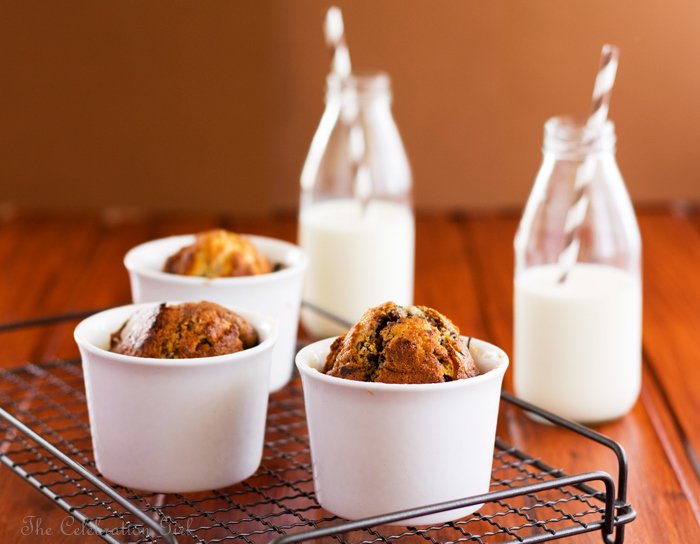
Here is the recipe I used:
Ingredients
4 large eggs
250 grs sugar
250 ml milk
250 ml sunflower oil
300 grs all-purpose flour
1 tablespoon baking powder
2 tablespoons cocoa powder
Preparation
Oil and flour a cake pan and pre-heat the oven to 180C.
Beat sugar and eggs until white and fluffy. Add oil and beat until well-integrated, and then add milk slowly, beating all the time.
In a different container, mix flour and baking powder. Whisk to integrate.
Add dry to wet ingredients in three times, integrating well before each new addition.
Separate the batter in two and add cocoa powder to one half.
Assemble the cake by pouring the batter in the center of the pan, using an ice cream scoop, alternating colours ( two scoops of vanilla batter, one scoop of cocoa batter, two scoops of vanilla batter, and so on).
Bake for 40 minutes at 180 C.
Note: If you change the size of the pan, remember that the oven times change as well! My mini cakes only took 18 minutes to be ready!
I hope that you like it! Have you ever made a zebra cake before?
Have a nice weekend!
by Marcela M. | May 18, 2012 | Blog, Main courses, Recipe Box, Recipes, Savories, Uncategorized
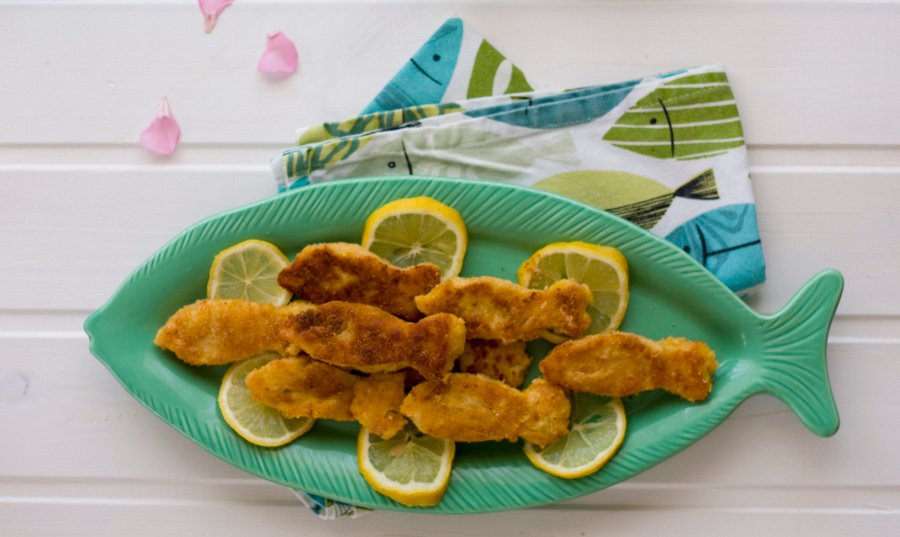
Good morning dear friends! Are you ready for the weekend?
Today I bring you a post with a delicious recipe that I discovered through Whole Kitchen cooking club, El Circulo Whole Kitchen.Whole Kitchen Magazine provides two recipes to its members every month ( one sweet and one savory), and the savory proposal for May 2012 was fish cakes.
I immediately liked the idea because, even though we live on an island, I have found it hard to incorporate fish into our diet, particularly that of our children. When I read the recipe for these fish cakes, I loved how versatile it was: I could shape them in different ways to make them more attractive for Luka and Zoe, and I could sneak in vegetables (Yes, I do that, I have picky eating toddlers!). The recipe also suits very well Cyprus lovely Spring weather, and it was perfect for a quick-lunch at the balcony, after the children came back from nursery school.
Whole Kitchen provided us with two different recipes: one from Jamie Oliver, which called for salmon and potatoes, and the other one from Trotamundos, which called for white fish, beans and potatoes. I decided to make my variation and used white fish fillets, potatoes, and butternut squash for a sweeter taste.
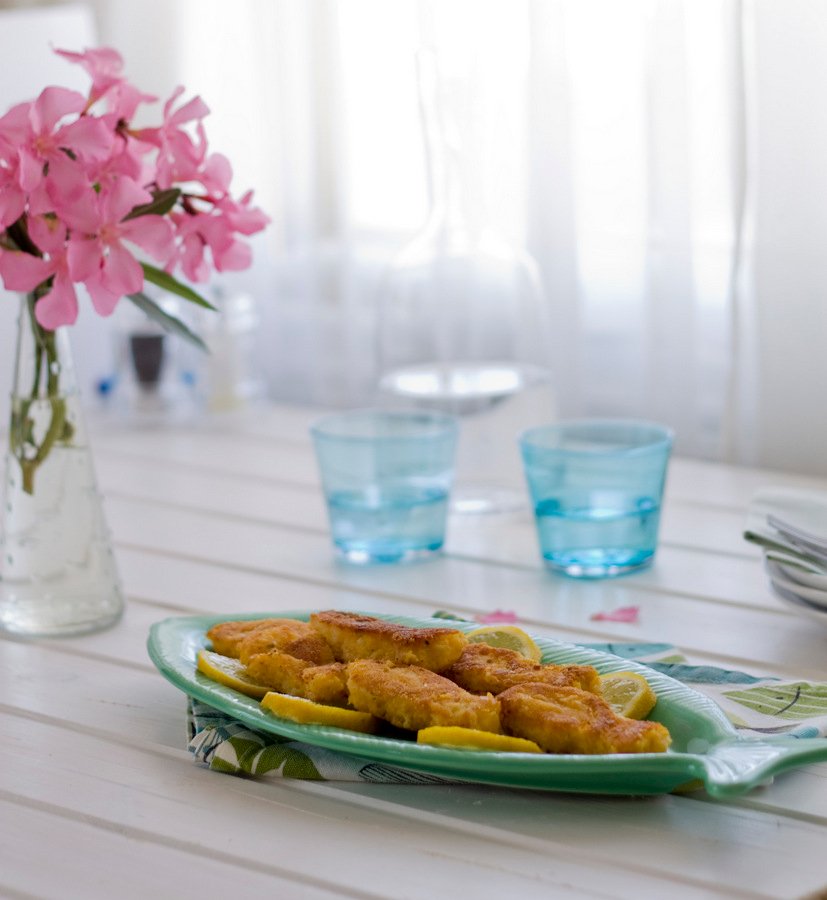
These fish cakes are really, really simple to make and they require very few ingredients: all you need is fish, potatoes and squash, plus one egg and a bit of flour and bread crumbs for assembling them, that’s all. The procedure couldn’t be easier but it may take a bit of time if you decide to give them a specific shape, as I did. First, you need to boil or steam the vegetables until very tender. In the meantime, cook the fish in the oven for about 10 minutes, drizzled with olive oil and covered in aluminum foil. Once everything is cooked, you simply have to mash the vegetables, add the fish and a bit of parsley (or other spice of your own preference) shape the cakes, flour them and fry them in just a bit of oil.
As I mentioned, I did not make these cakes round, as it is traditional. Instead, since I was going to be serving them to my children, I decided to use a fish-shaped cookie cutter to make them more enticing.
In order to give them this shape, I covered a cookie sheet with foil, extended the preparation on top, covered it with more foil and put the sheet in the fridge for half an hour, for it to get some consistency. After this time, I took it out and started cutting little fish with my cutter and placing them on a plate. Once I was done, I put the fish cakes back in the fridge for another half an hour. This is necessary for them not to lose their shape when you flour them.
After half an hour, I took the fish cakes out of the fridge, floured them (passing by flour, egg and bread crumbs) and fried them in just a tiny bit of oil, until golden. The next time I make them I will try to bake them in the oven, but since this was the first time, I decided to stick to the traditional cooking methods. Frying them makes them crispy on the outside while remaining soft on the inside – and they are just delicious!
I also decided to keep the flavours simple, so that the sweetness of the squash would be palpable, and therefore used as condiment only a bit of parsley, salt and pepper. You could be more adventurous, and try to add other spices either in the main mixture or by flavouring the bread crumbs with lemon zest or a Provençal mix (garlic and parsley), for example.
Fish cakes are traditionally accompanied by French fries, but I decided to go for a healthier option and opted for a quick, simple salad of cucumbers and cherry tomatoes instead. While I like to eat fried food on occasions, I don’t have a big resistance to it, and I find that I can tolerate them better if I eat them with fresh vegetables. I am a big fan of salads all year-long, but I must confess that I could pretty much live on them during the warmer months!
Here’s the recipe:
Ingredients:
– 3 fish fillets
– 2 medium-sized potatoes
– 5 slices of butternut squash
– Parsley, salt and pepper to taste
– Flour
– breadcrumbs
-Oil for frying
Preparation:
– Dice potatoes and squash and put in a saucepan, cover with water and bring to the boil until tender.
– Put the fish fillets in an oven tray, add salt and pepper and drizzle with olive oil. Cover with aluminum foil and cook for about 10 minutes.
– Mash the potatoes and squash. Crumble the fish fillets and add them to the vegetable purée. Add salt and pepper to taste and parsley, if desired.
– Shape small cakes with the help of your hands, place them on a tray, and put them in the fridge for half an hour. If you want to give the cakes a cookie cutter shape, extend the mixture on an oven tray covered in foil, put it in the fridge for half an hour, and only after this use the cookie cutter.
– Slightly beat one egg. Remove the cakes from the fish, flour them, dip them in egg, and pass them by bread crumbs so that these stick to them.
– Put a bit of oil in a frying pan and, once heated, add the fish cakes, until golden on both sides. Serve.
I hope you’ll like them!
Have a great weekend!
by Marcela M. | May 10, 2012 | Blog, cookies, Recipe Box, Recipes, South America, Sweets, Travel, Uncategorized
Good evening dear friends! I hope you had a lovely week.
This week, we continue with our introduction to typical Argentinian sweets, the ones we, Argentinians, love and miss when we are abroad. Today, I bring you some of my favourite bite-sized sweets. All of them, except branch chocolate and nuts confit, can be found in any kiosk, so they are great for an almost guilt-free sugar rush moment. Also, all of them, except for “bocadito maroc” include dulce de leche, because most of my fellow country-men would agree that “a desert without dulce de leche is not desert”. I have changed quite a bit in this regard since living abroad, but try baking a birthday cake with buttercream, jam or lemon curd for an Argentinian child (or adult!) and you will be met with a face of sheer disappointment!
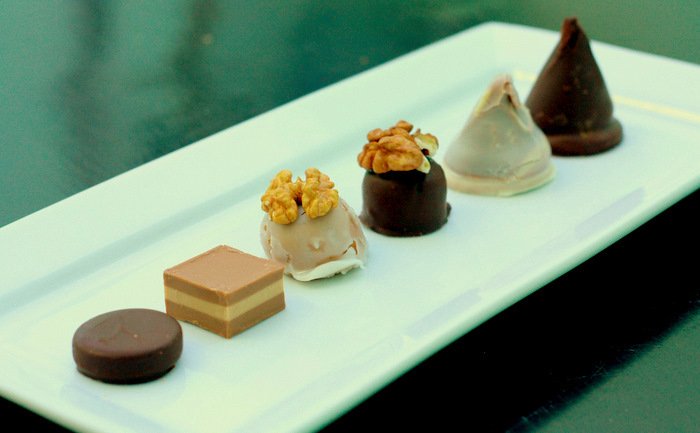
Let’s begin with Bocaditos Maroc, which are the bi-colour squares portrayed in the pictures above. They are made with a combination of peanut cream, milk and white chocolate. They are soft and truly melt in your mouth and, best of all, they are really easy to make at home so, if you want to give them a try, here’s how: Cover a square pan with foil. Process 100 grs of peeled roasted peanuts with 1 tablespoons of corn or canola oil until it reaches a pancake batter consistency. Melt 100 grs of milk chocolate and add 1/3 of the peanut cream to it. Mix well and place it in the pan, making sure it covers the pan evenly and smoothly. Bring to the fridge for about 15 minutes, so that the chocolate hardens. Melt 80 grs white chocolate and add another 1/3 of the peanut cream, mix well and pour it on top of the milk chocolate and peanut mixture. Put it in the fridge for another 15 minutes and, in the meantime, melt the remaining 100 grs of milk chocolate. Mix with the last 1/3 of peanut cream, and add it to the pan. Smooth the top with a spatula and place it in the fridge until hard. Once ready, remove from the pan, peel off the foil and cut into squares with a sharp knife (If you wet the knife in hot water, it will be easier to get a nice, clean-cut). And that’s all it takes!
The following treat is perhaps the most common of them all: Dulce de leche cones, or “Pinitos de dulce de leche”. They are simply, as you can see from the picture below, a truly decadent treat made of cookie, lots of dulce de leche disposed in a cone shape and covered in either dark or white chocolate.
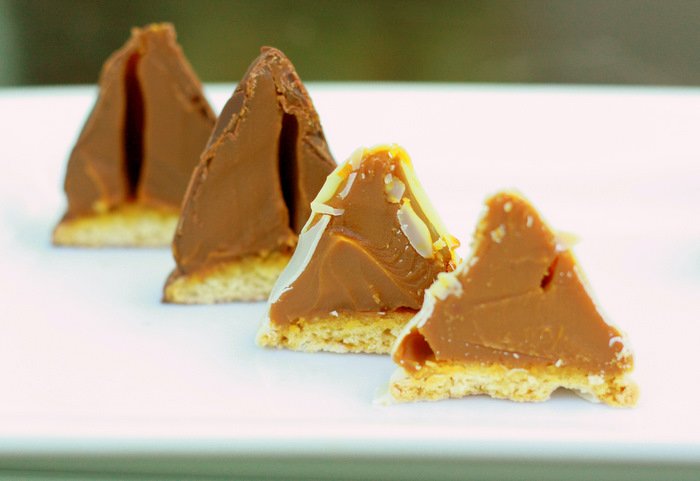
If you live outside of Argentina and you are familiar with regular dulce de leche, you may be wondering how it is possible for the cones to keep their shape. The answer is this: the cones are not made with regular dulce de leche, but with dulce de leche repostero, or “baking dulce de leche”, which is firmer and thicker than the regular one (which has a jam-like consistency).
Dulce de leche repostero, unlike regular dulce de leche, is not made solely of milk, sugar and vanilla. Now, be warned, here comes a big surprise: Dulce de leche repostero has bean pulp (pulpa de frijoles) and cornstarch to give it its consistency. Argentinian friends, if you don’t believe me, go check the ingredients listed in a can…I did it back in November and couldn’t believe my eyes!
If you want to make it at home, you should know that the proportions are different from the ones for regular dulce de leche: apart from adding the above ingredients, it takes three times more sugar. So, for every 5 litres of milk (as I did in the original recipe), you will need 3 kg of sugar, 2 1/2 cups of bean pulp (made soaking the beans overnight, then boiling them until very soft and finally passing them through a sieve), 10 tablespoons of cornstarch, 1 vanilla bean and 1 tablespoon of cornstarch. The procedure is pretty much the same as for regular dulce de leche, except for the addition of the beans which has to be done after the milk and sugar mixture starts to thicken (see the first stage of browning of my earlier post on dulce de leche). Right after adding the bean pulp and mixing everything very well with a wooden spoon, you should also add the cornstarch previously diluted in half a cup of cold milk. Then let time run its course and after a few hours you should be able to enjoy wonderful baking dulce de leche!
Another special treat that I look forward to eating when I go home are nueces confitadas, or “nuts confit”:

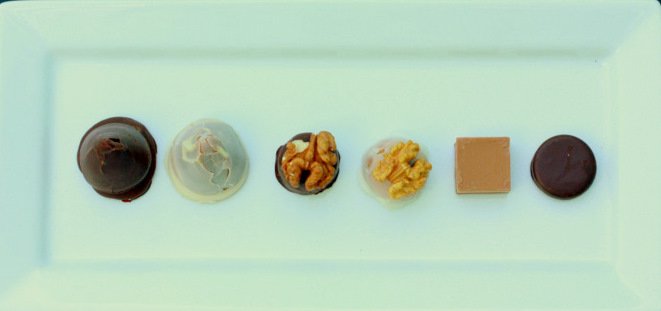
There are many recipes and ways to make them, but most of them involve three ingredients: dulce de leche repostero (see why you should know how to make it? 😉 , walnuts and poured fondant. The most traditional way consists of surrounding a full walnut in a spoon of dulce de leche and covering it all with poured fondant. Some, however, do it in a different way (as the ones that you can see in the picture above), which consists in making a paste with dulce de leche repostero and processed walnuts, giving it a ball shape and covering each ball in either poured fondant or dark chocolate.
The following picture shows another personal favourite, called Bocadito cabsha:

They are made with host capsules (yes, like the host of catholic mass. In Argentina they can be bought at baking supplies stores), dulce de leche, glucose, rum, and chocolate. The procedure is very simple: you need to heat the glucose in a pan, together with the dulce de leche, remove the pan from heat and add the rum, and fill the capsules with this preparation being careful not to overflow them. Finally, cover the capsules in chocolate, let them cool down for it to harden and enjoy!
Finally, chocolate en rama, or branch chocolate:
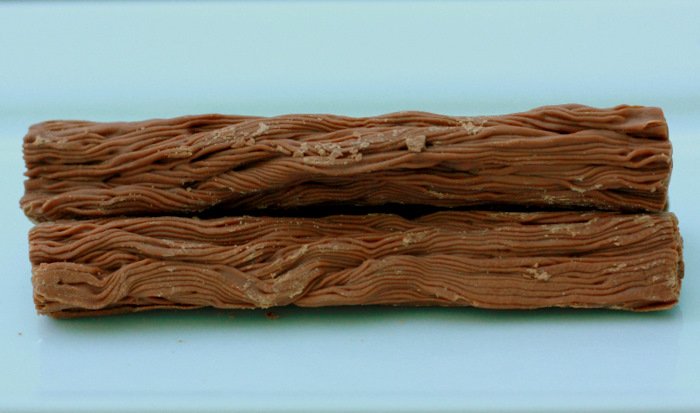
If you are curious about how it is made, check this video where you can see a real maitre chocolatier at work.
See you next week, with the last post on Argentinian sweets and a few recipes!
Have a wonderful weekend!

























